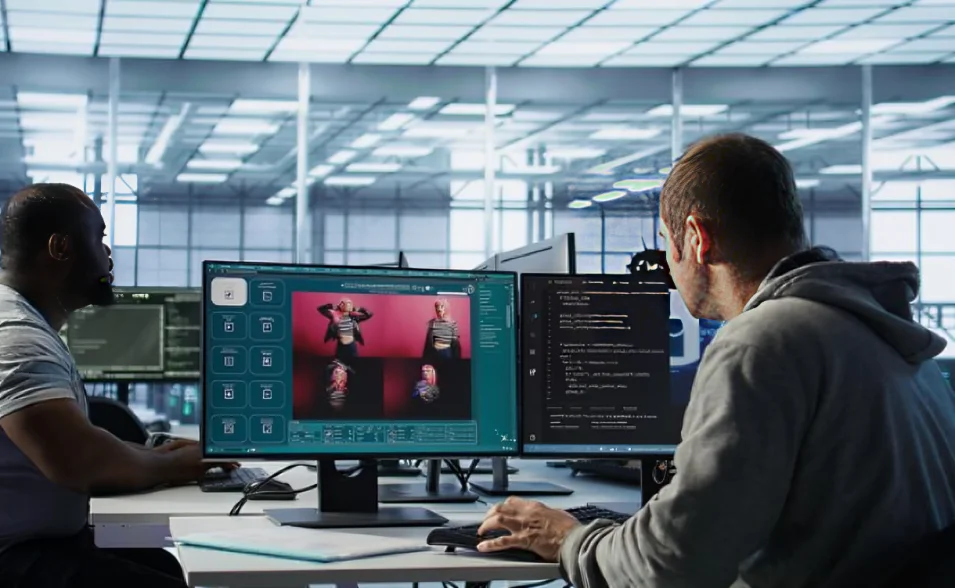In today’s fast-paced digital world, visuals dominate the way we communicate. Whether it’s a product photo on an e-commerce store, a travel snapshot on Instagram, or a historical picture in an archive, images tell powerful stories. But here’s the challenge: not everyone can “see” those stories. That’s where image to text description AI comes in.
This technology uses computer vision and natural language processing (NLP) to automatically generate descriptive captions for images. It’s like giving your computer a pair of eyes and a voice; it can “look” at an image, identify objects, understand scenes, and then write a text description that makes sense to humans.
For example, if you upload a picture of a golden retriever running on the beach, an advanced AI might generate:
“A golden retriever joyfully running along the shoreline under a clear blue sky.”
This kind of descriptive AI isn’t just a novelty; it has real-world uses in accessibility, SEO, social media engagement, and business automation. In this guide, we’ll break down how it works, where it’s used, its benefits, limitations, and best practices.
How Image to Text Description AI Works
At its core, image to text description AI combines two advanced technologies:
- Computer Vision – The AI analyzes pixels, shapes, colors, and patterns to detect objects, people, and surroundings.
- Natural Language Processing (NLP) – The AI converts that analysis into coherent, human-like sentences.
The Process Step-by-Step
- Image Upload – You provide the image (from a file, camera, or URL).
- Preprocessing – The AI adjusts brightness, sharpness, and filters noise for better detection.
- Object Recognition – It detects elements like “person,” “tree,” “car,” etc.
- Scene Understanding – It determines the setting (e.g., a park, office, kitchen).
- Relationship Mapping – AI figures out how objects relate (e.g., “child holding balloon”).
- Sentence Generation – NLP creates a grammatically correct, natural description.
This process happens in milliseconds, making it ideal for bulk caption creation or real-time applications.
Benefits of Image to Text Description AI

The rise of image to text description AI is not just about automation; it’s about improving accessibility, efficiency, and communication.
Accessibility with Image to Text Description AI
Many people rely on screen readers to understand web content. With AI-generated descriptions, they can “see” through words. A simple product photo becomes a vivid experience when described well.
SEO Benefits of Image to Text Description AI
Search engines can’t “see” images, but they can read text. By providing accurate, keyword-rich image descriptions, you make your content more discoverable in Google search and Google Images.
Time and Cost Efficiency
Instead of spending hours manually writing alt text for hundreds of images, AI can do it in minutes. Businesses save money on labor and speed up publishing timelines.
Consistency Across Content
AI ensures descriptions follow a uniform style, which is important for branding and professionalism.
Real-World Applications of Image to Text Description AI
This technology is making waves across industries, from tech startups to large corporations.
E-commerce
Online stores can instantly create product captions and alt text. This improves SEO, helps customers with disabilities, and reduces abandoned carts by giving buyers more details.
Social Media
Content creators use AI descriptions to make posts more engaging and accessible. For example, Instagram influencers can automatically generate captions for their photos.
Education
Teachers and students can use image-to-text AI for quick visual explanations, aiding both research and accessibility.
News & Journalism
Media outlets can quickly caption breaking news photos, making stories more informative and inclusive.
Comparing Free vs Paid Image to Text Description AI Tools

When choosing an image to text description AI tool, you’ll face two categories: free and paid.
Free Tools
- Great for casual users or small projects.
- Offer basic object recognition and simple captions.
- Limited daily usage and fewer customization options.
Paid Tools
- Suitable for professionals and businesses.
- More accurate, context-aware, and customizable.
- Support bulk processing, API integration, and multilingual captions.
Example:
- Free AI: “A man with a laptop.”
- Paid AI: “A young man in a blue shirt working on a silver laptop in a cozy coffee shop.“
Key Features to Look for in Image to Text Description AI Tools
When evaluating different AI tools, it’s important to know which features will have the most impact on quality and usability.
Accuracy in Object Recognition
The best AI tools don’t just detect “dog” , they recognize “golden retriever” and even add context like “playing in the snow.” Accuracy directly impacts how useful the generated description is.
Context Awareness
Some tools can understand the situation, mood, or relationship between objects. For instance, identifying not just a “cup” but a “cup of steaming coffee on a wooden desk during sunrise.”
Customizable Tone and Style
Professional marketers may want formal descriptions, while social media influencers prefer casual, playful captions. The ability to set tone is a big plus.
Multilingual Support
If you’re targeting global audiences, multilingual caption generation can expand your reach and accessibility.
Integration with Other Platforms
Look for tools that work seamlessly with CMS platforms like WordPress, Shopify, or social media schedulers to speed up workflow.
Using Image to Text Description AI for SEO Growth

Accessibility is more than a good practice; for many organizations, it’s a legal requirement.
Helping the Visually Impaired
People with visual impairments often rely on screen readers, which depend heavily on accurate image descriptions. AI-generated captions help ensure that no visual content is left without context.
Compliance with Accessibility Standards
Standards like WCAG (Web Content Accessibility Guidelines) and laws like the Americans with Disabilities Act (ADA) require accessible content. Using AI tools can help meet these standards by ensuring all images have alt text.
Inclusive User Experience
Accessibility features like AI descriptions benefit more than just those with disabilities , they help anyone in situations where images don’t load or when browsing with limited internet bandwidth.
Limitations of Image to Text Description AI
Even the most advanced AI isn’t perfect. Knowing its weaknesses helps you use it effectively.
Common Errors
- Overgeneralization – Describing a specific brand shoe as just “a shoe.”
- Context Misunderstanding – Misinterpreting a scene, like calling a wedding photo a “formal party.”
- Overly Literal Descriptions – Missing emotional tone or storytelling elements.
Dependence on Image Quality
Low-resolution, blurry, or overexposed images can confuse AI models, resulting in inaccurate descriptions.
Cultural & Contextual Nuances
AI may misinterpret cultural symbols or context-specific details without human oversight.
The Future of Image to Text Description AI
We’re just scratching the surface of what this technology can do.
Improved Contextual Intelligence
AI will soon be able to understand humor, sarcasm, and deeper emotional cues in images.
Integration with AR & VR
Imagine pointing AR glasses at a painting and instantly hearing a rich, detailed description , AI is making that possible.
Personalized Descriptions
Future systems could tailor image descriptions to different audiences , formal for business users, playful for kids, technical for specialists.
Step-by-Step Image to Text Description AI Guide
If you want to start generating image descriptions with AI, here’s a simple workflow:
- Choose a Reliable Tool – Consider accuracy, integrations, and cost.
- Prepare Your Images – Ensure clarity, good lighting, and proper framing.
- Upload and Process – Use the AI tool to scan and describe images.
- Review and Edit – Fix errors, add brand tone, and adjust keywords.
- Publish and Optimize – Add descriptions to your website, social media, or apps with proper alt tags.
Best Practices for Using Image to Text Description AI

Even the most advanced AI benefits from human guidance. Following best practices ensures your descriptions are accurate, accessible, and effective.
Always Review Before Publishing
While AI can handle the bulk of description work, manual review ensures tone accuracy, brand alignment, and fact-checking.
Add Extra Context
AI might say “A man holding a cup of coffee,” but you can enhance it with brand-specific or emotional elements like, “A smiling customer enjoying a cup of freshly brewed coffee at our café.”
Use Keywords Naturally
If you’re optimizing for SEO, insert keywords without overstuffing. For example, “AI-powered image description for e-commerce products” reads naturally while boosting search visibility.
Maintain Consistency
Stick to a style guide so all descriptions follow the same tone, whether casual, formal, or technical.
Top Image to Text Description AI Tools in 2025
Several AI tools stand out for accuracy, ease of use, and features.
Google Cloud Vision
- Strong object recognition and OCR.
- Great for developers who want API integration.
Microsoft Azure Computer Vision
- Reliable, context-aware captions.
- Integrates well with enterprise software.
Caption AI (Standalone App)
- User-friendly, designed for bloggers and marketers.
- Includes tone customization and bulk processing.
OpenAI’s Multimodal Models
- Cutting-edge understanding of image content.
- Generates natural, human-like descriptions.
Integrating Image to Text Description AI into Workflow

Seamless integration saves time and boosts productivity.
- For Content Creators: Connect AI tools directly to content management systems for instant captions.
- For Developers: Use APIs to embed description generation into apps or websites.
- For Businesses: Automate alt text creation for product images across your entire e-commerce catalog.
Example: A real estate site could auto-generate property photo descriptions and instantly publish them on listing pages.
Custom Training for Image to Text Description AI Models
If off-the-shelf tools don’t meet your needs, training a custom AI model may be the solution.
Collect a Dataset
Gather thousands of labeled images with accurate descriptions.
Choose a Model Architecture
Popular options include CNN + LSTM networks or transformer-based models.
Train & Test
Use machine learning frameworks like TensorFlow or PyTorch to train your model, then test accuracy against real-world images.
Deploy
Host your model on a cloud service for scalable, real-time image-to-text generation.
Future Trends in Image to Text Description AI
As with any AI technology, ethics matter.
Bias in Descriptions
If a dataset is biased, the AI might produce stereotypical or unfair captions.
Privacy Concerns
Avoid uploading sensitive images to untrusted platforms.
Transparency
Clearly disclose when descriptions are AI-generated, especially in journalism or official publications.
Conclusion
Image-to-text description AI is transforming how we interact with digital content. From boosting accessibility for visually impaired users to improving SEO rankings and streamlining workflows, it’s more than just a convenience; it’s becoming a necessity. As the technology evolves, we can expect even more context-aware, emotion-rich, and audience-specific captions that bridge the gap between visual and textual communication.
Whether you’re running an e-commerce store, managing a social media brand, or simply making your content more inclusive, adopting this AI technology now puts you ahead of the curve. The key is to combine automation with human creativity, letting AI handle the bulk work while you fine-tune for personality, emotion, and accuracy.
If used responsibly, image-to-text description AI can make the internet a more accessible, engaging, and connected place for everyone.
FAQs About Image to Text Description AI
- What is image to text description AI?
It’s an AI-powered tool that analyzes images and generates human-like text descriptions, improving accessibility and SEO. - Can AI generate descriptions for complex scenes?
Yes, advanced models can recognize multiple objects, relationships, and contexts, though human review is still recommended. - Is image to text AI free?
Some tools are free with limited features, while premium versions offer more accuracy, customization, and bulk processing. - How does this AI help SEO?
Search engines can’t “see” images, but they can read descriptions. Well-written AI-generated alt text can boost visibility. - Are there privacy risks in using this AI?
Yes, avoid uploading sensitive or private images to platforms you don’t trust. Always check data handling policies.










